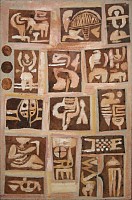BIOGRAPHY

LUCKY SIBIYA
(b. 1942 - 1999, Vryheid, South Africa)
Lucky Sibiya is internationally renowned for his abstract paintings and sculptural carvings.
The artist´s fascination with the abstract began in his childhood, partly due to his presence at his father´s consultations as a Sangoma. Here strange and beautiful artifacts were used to assist in diagnostic and traditional healing medicine.
The destruction of the colourful neighbourhood of Sophiatown during the Fifties resulted in the Sibiya family relocating to Soweto. During his school years he was sent away to Hammanskraal where the young boy experimented with woodcarvings. Shortly before completing his school education at St. Peter´s Seminary, Lucky introduced himself to Cecil Skotnes, armed with some of his painted ´found´ objects. Skotnes was at this time one of South Africa´s foremost contemporary artists. He was head of the Polly Street Art Centre in Johannesburg and he promoted young talent. Skotnes was enthusiastic to accept Sibiya as a private pupil. His mentor´s engraved paintings were influential in Sibiya´s decision to paint on carved wood.
Sibiya has taken folk art to its most expressive and sophisticated levels. By rubbing powdered pigments into richly engraved images, Sibiya´s composition progressed from purely decorative to a conceptually abstract vision. As the artist matured, his leaning to carve, rather than to engrave, presented what would emerge as Sibiya´s unique signature. The most distinctive features of his style are his use of organic shapes which are connected with flowing, rhythmic lines, juxtaposed on a background of often complex carved and painted relief and intaglio spaces.
For the last thirty years his work has moved towards more deeply carved studies on a two dimensional plane and working the wood into an almost three dimensional art form. Compounding this form is his addition of intricately worked found objects. These include clothing, steel, leather and richly rusted metals. Over the years he has devised a language of abstract symbols; unique and instantly recognizable.
The physical demand of Sibiya´s technique is matched only by the harmonious, spiritual feeling experienced when transported into his world of ritual. Key elements of his figurative work include ancient tribal traditions and rites of passage.
In addition to his contribution to the visual arts during the mid seventies, Sibiya has also contributed to the performing arts with his portfolio illustrations of classic drama. His work, inspired by Welcome Msomi´s adaptation of "Macbeth" was highly acclaimed at that time and travelled to the Royal Ceasaria Theatre in Israel and the Old Vic Theatre in London. This Umbatha portfolio was well received in Australia where it featured at the South African Exhibition in Canberra.
Lucky Sibiya died in a road accident on 24 January 1999.



